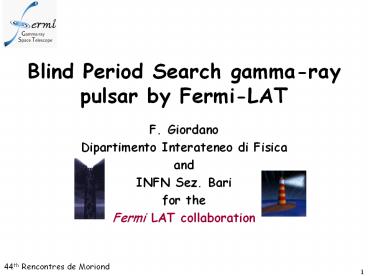Blind Period Search gamma-ray pulsar by Fermi-LAT - PowerPoint PPT Presentation
Title:
Blind Period Search gamma-ray pulsar by Fermi-LAT
Description:
The -ray flux from the CTA 1 pulsar corresponds to about 1-10% of Erot ... These new pulsar discoveries will enable a population study of radio-quiet vs. ... – PowerPoint PPT presentation
Number of Views:48
Avg rating:3.0/5.0
Title: Blind Period Search gamma-ray pulsar by Fermi-LAT
1
Blind Period Search gamma-ray pulsar by Fermi-LAT
- F. Giordano
- Dipartimento Interateneo di Fisica
- and
- INFN Sez. Bari
- for the
- Fermi LAT collaboration
2
Where we were the EGRET Pulsars
Vela, Crab Geminga are the brightest sources in
the Gamma-ray sky Their Flux for Egt100MeV
10-510-6ph/cm2s
- PSR B1706-44
- Flux 1.1 10-6ph/cm2s
- PSR B195132 PSR B1055-52
- Flux for Egt100MeV 10-7ph/cm2s
3
Where we started
4
Where we are
Pulses at 1/10th true rate
5
Search for new ?-ray pulsars
The Geminga candidates
1. Radio-quiet gamma-ray sources list generated
pre-Launch, with very accurate source locations
from other wavelengths. a. 3EG J18355918
(possibly the next Geminga) b. CTA1
(recently published in Science) c. Compact
objects of Pulsar Wind Nebulae (PWNe) d.
Milagro sources (e.g. MGROJ201937) 2. Fermi-LAT
sources a list of gamma-ray sources generated
post-Launch with a Fermi localization
6
The Blind Period Search
The spin parameters (frequency, spin-down) are
unknown, so to resolve the phase plot, a search
over f, df/dt parameter space has to be
implemented to find the timing solution.
Limitations 1. Gamma-ray photon data is
exceptionally sparse (103?104 photons per yr
). 2. Such long datasets make fully coherent
methods like FFTs require large numbers of fdot
trials to prevent smearing of the signal. This
large number of trials would also greatly reduce
the significance of the signal. 3. FFTs of this
magnitude require large amounts of memory 1
month _at_ 64 Hz 331 million bins 5.3 GB of
memory! 4. If the pulsar were to glitch (suddenly
change its frequency), then the signal power
would diminish greatly.
7
The Time-Differencing Technique
Periodicity in photon arrival times will also
show up in differences of photon arrival times.
Time differences cancel out long term phase
slips because differencing starts the "clock"
over (and over, and over...) Despite the reduced
frequency resolution (and therefore number of
bins), the sensitivity is not much reduced
because of a compensating reduction in the number
of fdot trials
8
The First Candidate
9
The First discovery
Science, Volume 322, Issue 5905, pp. 1218-
(2008).
CTA 1 pulsar (2 cycles, P315.86 ms)
- ?-ray source at l,b 119.652, 10.468
- 95 error circle radius 0.038 contains the
X-ray source RX J000707302, central to the PWN
superimposed on the radio map at 1420 MHz. - Pulsar off-set from center of radio SNR rough
estimate of the lateral speed of the pulsar is
450 km/s
- Exhibits all characteristics of a young
high-energy pulsar (characteristic age 1.4 x 104
yr), which powers a synchrotron pulsar wind
nebula embedded in a larger SNR. - Spin-down luminosity 1036 erg s-1, sufficient
to supply the PWN with magnetic fields and
energetic electrons. - The ?-ray flux from the CTA 1 pulsar corresponds
to about 1-10 of Erot (depending on beam
geometry)
P 315.8 ms Pdot 3.6110-13s/s
9
10
EG UnID sources
3EG J1734-3232
3EG J1826-1302 (Eel)
3EG J1420-6038 (Rabbit)
3EG1809.5 (Taz)
3EG J1741-2050
3EG J06310642
3EG J19582909
3EGJ2020 Gamma-Cigny
3EG J20334118
11
More Blind Search Pulsars (not in 3EG )
1 MGRO 2 new Fermi Sources
PSR J22385852
PSR J1907.50601 MGRO J190806
PSR J0357.53211
12
First population study
Blind search pulsars ATNF pulsars
1012 1011 1010 109 108 107 106 105 104 103 102 101
Flux (Ph/cm2s)
Age (yr)
Edot (erg/s)
1012 1011 1010 109 108 107 106 105 104 103 102 101
P1
Age (yr)
P0
B Strength (Gauss)
13
Conclusions
- 13 new (potentially radio-quiet) gamma-ray
pulsars have been discovered in 3 months of
Fermi-LAT data - 10 out of 13 of these blind
period search pulsars have an EGRET source
location (3EG). Since two-thirds of EGRET sources
remain unidentified, and this is a good step in
identifying them. - These pulsars have an age
distribution 10 kyr - 1.8 Myr and spin-down
luminosity distribution 1033 erg/s - 1036
erg/s - These new pulsar discoveries will enable
a population study of radio-quiet vs. radio-loud
pulsars which will provide new information on the
emission geometry in these sources and the
galactic populations of these high energy
emitters. - Deep radio pulsar searches of the new
gamma-ray only pulsars have begun, in order to
get strong constraints on the radio luminosity.
14
(No Transcript)































